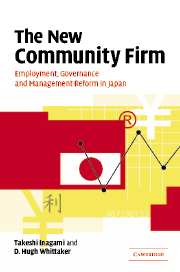Book contents
- Frontmatter
- Contents
- List of figures
- List of tables
- Preface
- Acknowledgements
- Part 1 The End of the Community Firm?
- Part 2 Hitachi: ‘Here, the Future’
- 8 Hitachi: A Dancing Giant
- 9 A Victim of its Own Success?
- 10 Organization Reform
- 11 Recasting the Employment Relationship
- 12 The Impact on Industrial Relations
- 13 Evaluation
- Part 3 The Reformed Model
- Appendix: Changes in Job Tenure
- References
- Index
12 - The Impact on Industrial Relations
Published online by Cambridge University Press: 22 September 2009
- Frontmatter
- Contents
- List of figures
- List of tables
- Preface
- Acknowledgements
- Part 1 The End of the Community Firm?
- Part 2 Hitachi: ‘Here, the Future’
- 8 Hitachi: A Dancing Giant
- 9 A Victim of its Own Success?
- 10 Organization Reform
- 11 Recasting the Employment Relationship
- 12 The Impact on Industrial Relations
- 13 Evaluation
- Part 3 The Reformed Model
- Appendix: Changes in Job Tenure
- References
- Index
Summary
Our discussion of organization and governance reforms (chapter 10) and HRM reforms (chapter 11) would be incomplete without considering the collective, industrial relations dimension. What were the implications of the reforms for industrial relations? Conversely, how did industrial relations considerations influence the design and implementation of the reforms?
As we shall see, the union had its own reasons to seek change, in part to preserve employment, but also to meet the changing aspirations of its members. Failure to participate in reform, too, would diminish its influence. On the other hand, participation could also diminish its influence, through a fracturing or even break-up of the union, and individualized HRM. How did the union face this dilemma? And, independently of such challenges, how did it deal with challenges from within, such as growing member apathy, and the ascendance of ‘knowledge workers’? These are questions we will consider in this chapter.
First we will look at industrial relations developments in the 1990s prior to 1998, and then at the industrial relations dimension of the HRM and organization reforms. Most corporate restructuring programmes have both ‘high road’ (value creating) and ‘low road’ (cost cutting) elements. We will see that industrial relations considerations and processes helped to tip the balance towards the former. Additionally, in order to avoid the danger of becoming a victim of change, accomplice of ‘low road’ policies or simply a bearer of bad news, the union also undertook reforms, and changed its modus operandi which was predicated on (pre-reform) corporate and industrial relations stability.
- Type
- Chapter
- Information
- The New Community FirmEmployment, Governance and Management Reform in Japan, pp. 198 - 215Publisher: Cambridge University PressPrint publication year: 2005



